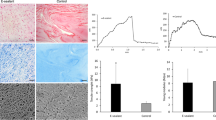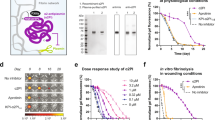Abstract
Fibrin glue is used as a hemostatic and adhesive agent. Until recently, safety issues had delayed approval of the commercial preparation in the United States. Fibrin glue has found several urologic applications, especially as an adhesive agent. It has excellent potential in laparoscopic surgery, where conventional tissue approximation techniques are cumbersome and time-consuming. Fibrin glue has also been used as a delivery vehicle for autologous cell transplantation and may play a major role in tissue engineering techniques in the future.
Similar content being viewed by others
References and Recommended Reading
Radosevich M, Goubran HI, Burnouf T: Fibrin sealant: scientific rationale, production methods, properties, and current use. Vox Sang 1997, 72:133–143. An excellent review of the historical development of fibrin glue, the physiology and mechanism of action, production methods, and a broad view of its clinical uses.
Hino M, Ishiko O, Honda KI, et al.: Transmission of symptomatic parvovirus B19 infection by fibrin sealant used during surgery. Br J Haematol 2000, 108:194–195.
Jackson MR, Alving BM: Fibrin sealant in preclinical and clinical studies. Curr Opin Hematol 1999, 6:415–419.
Kiilholma P, Haarala M, Polvi H, et al.: Sutureless endoscopic colposuspension with fibrin sealant. Tech Urol 1995, 1:81–83.
Philippe HJ, Perdu M, Dompeyre P, et al.: Transvaginal colpo-urethropexy with fibrin sealant: 4 years follow-up in 23 cases. Eur J Obstet Gynecol Reprod Biol 1996, 27:157–158.
McKay TC, Albala DM, Gehrin BE, Castelli M: Laparoscopic ureteral reanastomosis using fibrin glue. J Urol 1994, 152:1637–1640.
Anidjar M, Desgrandchamps F, Martin L, et al.: Laparoscopic fibrin glue ureteral anastomosis: experimental study in the porcine model. J Endourol 1996, 10:51–56.
Eden CG, Sultana SR, Murray KH, Carruthers RK: Extraperitoneal laparoscopic dismembered fibrin-glued pyeloplasty: medium-term results. Br J Urol 1997, 80:382–389. This study of eight patients, who had laparoscopic retroperitoneal pyeloplasty using fibrin glue, showed that it was associated with shorter operative times than traditional laparoscopic pyeloplasty.
Peschel R, Janetschek G, Bartsch G: Dismembered or nondismembered pyeloplasty—what is the ideal technique for laparoscopic pyeloplasty (abstract #826)? In Abstracts of the 92nd AUA Annual Meeting, New Orleans; 1997:21.
Vankemmel O, Rigot JM, Burnouf T, Mazeman E: Delayed vasal reanastomosis in rats: comparison of a microsurgical technique and a fibrin-glue procedure. BJU Int 1996, 78:271–274.
Morita T, Tokue A: Successful endoscopic closure of radiation induced vesicovaginal fistula with fibrin glue and bovine collagen. J Urol 1999, 162:1689.
Morita T, Tachikawa N, Tokue A: Successful closure of neovesicocutaneous fistula with fibrin glue. Urol Int 1998, 61:130–131.
Eden CG, Coptcoat MJ: Assessment of alternative tissue approximation techniques for laparoscopy. Br J Urol 1996, 78:234–242.
Wolf JS Jr, Soble JJ, Nakada SY, et al.: Comparison of fibrin glue, laser weld, and mechanical suturing device for the laparoscopic closure of ureterotomy in a porcine model. J Urol 1997, 157:1487–1492. This animal study compared fibrin glue with other modalities for laparoscopic closure of a ureterotomy. Ease of use, duration to perform closure, pressure flow studies, radiographic appearance, and histology are compared among the different groups. Although all groups compared favorably with free-needle suturing, fibrin glue produced better radiologic findings, flow characteristics, and histology.
Beduschi R, Beduschi MC, Wojno KJ, et al.: Antifibrinolytic additives to fibrin glue for laparoscopic wound closure in urinary tract. J Endourol 1999, 13:283–287.
Avanoglu A, Celik A, Ulman I, et al.: Safer circumcision in patients with hemophilia: the use of fibrin glue for local hemostasis. BJU Int 1999, 83:91–94.
Riccabona M: Reconstruction or substitution of the pediatric urethra with buccal mucosa: indications, technical aspects and results. Tech Urol 1999, 5:133–138.
Jackson MR, Taher MM, Burge JR, et al.: Hemostatic efficacy of a fibrin sealant dressing in an animal model of kidney injury. J Trauma 1998, 45:662–665.
Janetschek G, Daffner P, Peschel R, Bartsch G: Laparoscopic nephron sparing surgery for small renal cell carcinoma. J Urol 1998, 159:1152–1155. Seven patients who underwent laparoscopic wedge-resection of small renal tumors are reported in this study. Resection was performed using bipolar cautery, argon beam coagulator, and fibrin glue. It demonstrates the potential for use of fibrin glue in laparoscopic urology.
Wechselberger G, Scholler T, Stenzl A, et al.: Fibrin glue as delivery vehicle for autologous urothelial cell transplantation onto a prefabricated pouch. J Urol 1998, 160:583–586. This important animal study is the first to demonstrate that cultured urothelial cells can be successfully reimplanted onto a prefabricated capsule-pouch using fibrin glue. This technique may hold huge potential for future reconstructive urological surgery.
Author information
Authors and Affiliations
Rights and permissions
About this article
Cite this article
Kumar, U., Albala, D.M. Fibrin glue applications in urology. Curr Urol Rep 2, 79–82 (2001). https://doi.org/10.1007/s11934-001-0029-5
Issue Date:
DOI: https://doi.org/10.1007/s11934-001-0029-5




